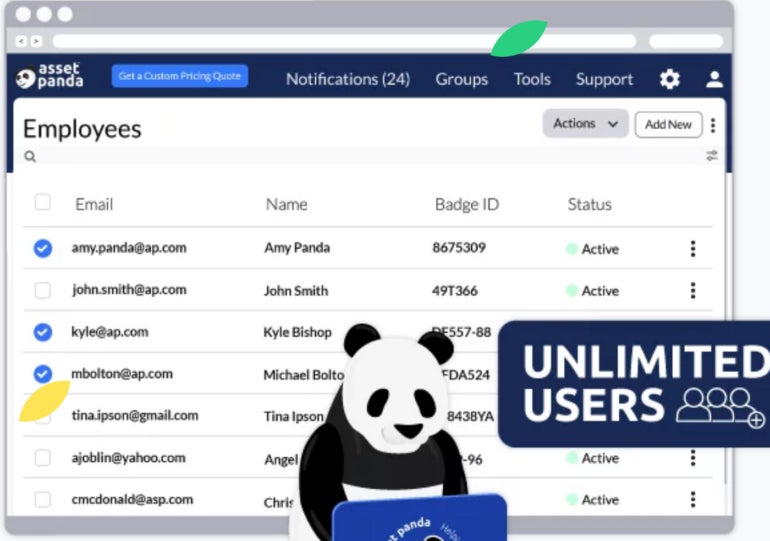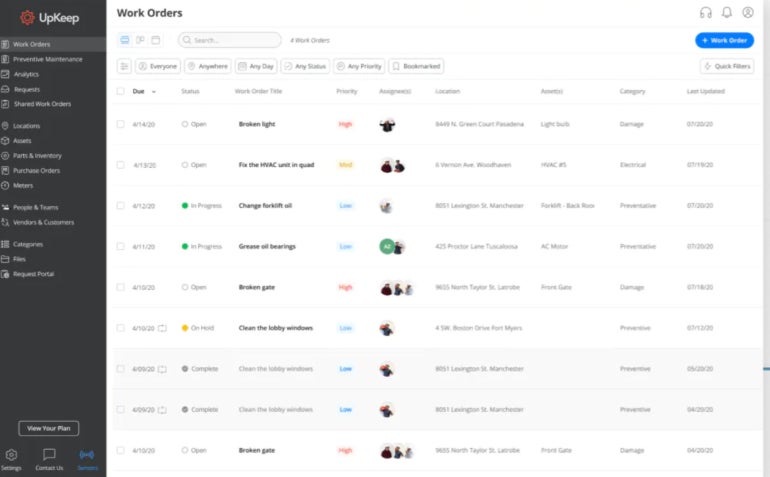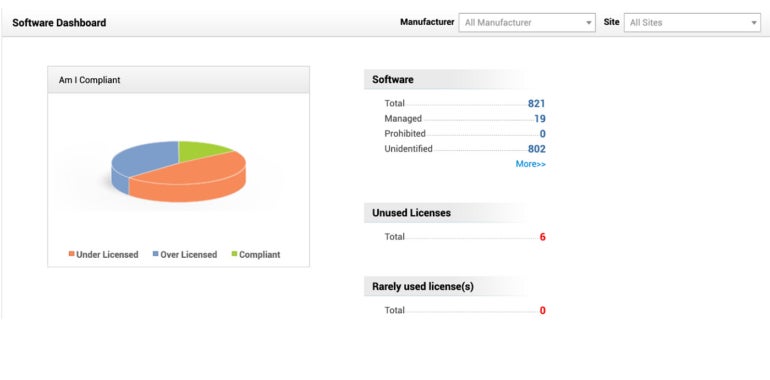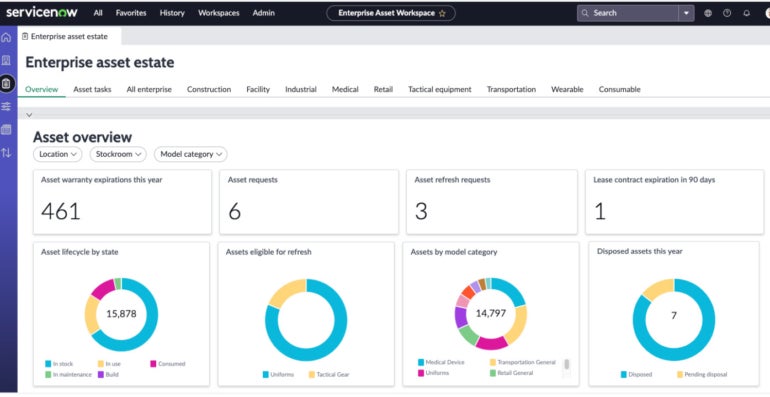-
Asset Panda: Best for allowing unlimited users
-
SysAid: Best for ticket automation
-
Freshservice: Best for intelligent alerting system
-
UpKeep: Best for operations team
-
ManageEngine AssetExplorer: Best for IT asset life cycle management
-
ServiceNow: Best for automating software licensing
-
GoCodes: Best for hardware tracking
-
Ivanti Neurons: Best for automated asset discovery
IT assets are software, hardware or cloud resources that help businesses run their operations. Managing these assets efficiently is crucial for optimizing productivity, reducing costs and ensuring compliance with various regulations. Fortunately, there are IT asset management solutions available for that.
IT asset management software provides a unified snapshot of IT assets for better visibility, risk reduction and efficient and strategic IT spending. If you’re on the lookout for an ITAM solution, here are the best options.
Jump to:
- IT asset management software comparison
- Key features of IT asset management software
- How do I choose the best IT asset management software for my business?
- Methodology
IT asset management software comparison
| Software | Automated asset discovery | Contract management | Barcode and QR code asset tagging | Deployment options | Pricing |
|---|---|---|---|---|---|
| Asset Panda | Yes | Yes | Yes | Cloud | Contact the vendor for a quote |
| SysAid | Yes | Yes | Yes | Cloud or On-premises | Contact the vendor for a quote |
| Freshservice | Yes | Yes | No | Cloud | Starts at $19 per agent per month |
| UpKeep | Yes | Yes | Yes | Cloud | Starts at $45 per month per user |
| ManageEngine AssetExplorer | Yes | Yes | No | Cloud and On-premises | Contact the vendor for a quote |
| ManageEngine AssetExplorer | Yes | Yes | Yes | Cloud | Contact the vendor for a quote |
| GoCodes | Yes | Yes | Yes | Cloud | Starts at $500 per year for 200 quantity assets and 3 users. |
| Ivanti Neurons | Yes | Yes | Yes | Cloud | Contact the vendor for a quote |
Asset Panda: Best for allowing unlimited users
Asset Panda is an asset management tool that can track anything, including IT assets. Asset Panda takes a flexible approach to asset management, enabling teams to custom-tailor the platform to fit their specific needs (Figure A). Asset Panda also provides access to unlimited users. Anyone who must track IT assets has the ability to do so in one centralized location.
Figure A

Pricing
Contact the vendor for a quote.
Key Features
- Easy-to-use interface for centralized IT asset management.
- Mobile app for monitoring and updating IT asset data from any mobile device.
- Notifications and alerts for required repairs and other events.
- Maintenance tracking capabilities from request to fulfillment.
- Barcode and QR Code Scanning.
Pros
- Mobile accessibility.
- Unlimited users.
- Easy onboarding of assets and teams.
- Demo is available on the site for an easy understanding of how the tool works.
- Supports unlimited users.
Cons
- The mobile app has limited functionality compared to the web platform.
- Insufficient pricing information.
SysAid: Best for ticket automation
SysAid is a provider that offers everything from a robust IT service desk to full IT asset management. SysAid’s asset management tools are built to fit right into any service desk to boost efficiency and improve visibility.
For example, IT teams can benefit from inventory management, including support for hardware and software assets. Other notable features include the ability to set up custom monitoring and receive real-time alerts (Figure B).
Figure B

Pricing
Contact the vendor for pricing.
Key Features
- Full IT asset management for physical and digital assets.
- Automated IT issue identification with real-time alerts and notifications.
- Hundreds of app and software integrations.
- Simplified inventory development through configuration management database capabilities.
Pros
- Track and get real-time alerts.
- Granular level alerting for changes in CPU, network equipment, memory usage and more.
- Automatically imports data into configuration management database.
- Automates IT Issue Identification.
Cons
- Requires personal information to get pricing information.
- The UI can be improved.
Freshservice: Best for intelligent alerting system
Freshservice by Freshworks is a full-service suite of IT asset management tools. A hallmark feature of Freshservice is the platform’s automated discovery capabilities. Using the tool’s Discovery Probe, IT teams can quickly scan all IT assets in real-time to update asset data (Figure C). These discovery solutions work with all types of assets, from hardware to virtual machines.
Figure C

Freshservice also offers features such as relationship mapping, full asset life cycle management, contract management and built-in software-as-a-service management.
Pricing
Freshwork’s IT management pricing is captured under its Freshservice and comes with a 14-day free trial across all prices. Pricing is categorized into four levels:
- Starter: Starts at $19 per agent per month.
- Growth: Starts at $49 per agent per month.
- Pro: Starts at $98 per agent per month.
- Enterprise: Starts at $119 per agent per month.
Key Features
- Automated discovery capabilities for tracking and analyzing all IT assets
- Hundreds of app integrations, including Jamf, VMware and more
- SaaS management for automating actions across SaaS platforms
- Asset management tools from deployment to retirement
- License management capability.
- Integration with generative AI.
Pros
- Supports intelligent alert management rules.
- Mobile accessibility.
- Offers free trial.
- Built-in ticketing system to track IT support and service requests
Cons
- Pricing could be costly for small businesses.
- Some users complain that the UI is not intuitive enough.
SEE: Freshservice is also considered a top project management ticketing system.
UpKeep: Best for operations team
UpKeep is different from the other platforms on this list in that it combines computerized maintenance management system, enterprise asset management and application performance management capabilities into one solution. Through UpKeep’s Asset Operations Management Platform, teams can monitor asset maintenance, manage assets throughout their life cycles and improve asset performance (Figure D).
Figure D

UpKeep’s unique capabilities make the platform a great choice for IT teams in technical industries such as manufacturing, government, fleet management and utilities. Plus, UpKeep is a mobile-first platform, enabling teams to track and manage their assets from anywhere.
Pricing
UpKeep offers three pricing plans with a 14-day free trial.
- Starter: Starts at $45 per month per user.
- Professional: Starts at $75 per month per user.
- Business Plus: Contact the vendor for a quote.
Key Features
- Centralized platform for CMMS, EAM and APM needs
- Business intelligence dashboard for tracking costs and other asset data
- Internet of Things wireless sensor capabilities through UpKeep Edge
- App integrations to centralize the entire tech stack
- Built-in reporting and analytics.
Pros
- Offers a free trial.
- Supports preventive maintenance.
- Good learning curve and proper documentation.
- Availability of demo.
- Mobile accessibility.
- Offers a learning center for easy learning.
Cons
- Asset Downtime Tracking is only available on the Business Plus plan.
- Pricing may not be suitable for small organizations.
- Custom Dashboard support is only available on the Business Plus plan.
ManageEngine AssetExplorer: Best for IT asset life cycle management
ManageEngine’s AssetExplorer is a web-based, end-to-end asset management tool. AssetExplorer enables teams to manage IT assets, including hardware and software, from deployment to retirement.
A key feature of AssetExplorer is the built-in software license management tools. Teams can manage all types of licenses, including individual licenses, original equipment manufacturer licenses and enterprise licenses (Figure E). As a result, IT teams can ensure license compliance.
Figure E

Other capabilities include IT asset inventory management, software asset management, CMDB and purchase order management. AssetExplorer is different from other options on this list, as the platform offers a free edition that can be used by teams with fewer assets.
Pricing
Although no specific pricing is provided on the vendor’s website, AssetExplorer is available in three editions.
- Free: This is a free edition of the software that is restricted to 25 nodes.
- Trial: This edition comes with all functionality but is only valid for the trial period.
- Professional: This version of the license is valid until the license expires.
Key Features
- Full IT asset management capabilities, including life cycle and inventory management
- Centralized repository of all configuration items via CMDB capabilities
- Built-in reports and customized reporting capabilities
- Mobile capabilities for managing assets on-the-go
- Auto-discovery capabilities
- Free version available.
Pros
- Cross-platform compatibility – Windows, Linux and macOS assets.
- Supports software license compliance.
- Supports Purchase Orders and Contracts tracking.
- IT Asset lifecycle management.
- Supports mobile apps for both iOS and Android.
Cons
- Poor user interface.
- Lacks adequate license information.
ServiceNow: Best for automating software licensing
ServiceNow is a platform used by IT teams to connect all IT workflows, from service management to portfolio management. ServiceNow’s IT Asset Management solution enables IT teams to automate the life cycle of software, hardware and cloud-based assets. Built-in capabilities include everything from hardware asset management to IT asset offboarding and beyond.
These capabilities are built on ServiceNow’s Now Platform, which enables IT teams to use one centralized source for all assets. Plus, teams can automate their asset management workflows using built-in, no-code playbooks.
ServiceNow integrates with a wide range of other apps and services to help IT teams improve efficiency. Examples of current integrations include Jamf, Microsoft and IBM.
Figure F

Pricing
Contact the vendor for a quote.
Key Features
- Complete IT asset management, including hardware management and software management
- Cloud-based asset management capabilities
- Hardware-specific features, including asset inventory audit capabilities and a hardware-specific dashboard
- SaaS license management, including a SaaS-specific dashboard and software spend detection capabilities
- Asset onboarding and offboarding capabilities
Pros
- Workflow automation.
- Single data model that removes IT information silos.
- Easy learning curve.
- Risk scoring functionality to know the assets at risk and to what degree.
Cons
- No pricing details.
- Absence of free trial.
SEE: Explore how ServiceNow compares to Jira Service Management.
GoCodes: Best for hardware tracking
GoCodes’ asset tracking solution provides custom QR code tracking for everything from desktop computers to routers and beyond. Teams can use the mobile scanning app to complete asset-specific tasks from anywhere (Figure G).
Figure G

GoCodes also features robust reporting and analytics tools so teams can see in-depth data about their assets in real-time. Users can utilize the built-in check-in/check-out solution to check IT equipment out when necessary to simplify collaboration and tracking.
Pricing
GoCodes offers a five-level pricing tier with a 15-day free trial:
- Standard: Starts at $500 per year for 200 quantity assets and 3 users.
- Premium: Starts at $1,000 per year for 500 quantity assets and 5 users.
- Premium Elite: Starts at $1,750 per year for 1,000 quantity assets and 10 users.
- Professional: Starts at $2500 per year for 2,000 quantity assets and 20 users.
- Enterprise: Supports over 2,000 assets and more than 20 users. Requires you to contact the vendor for a quote.
Key Features
- Custom QR code labels and automatic GPS tracking.
- Fully customized reporting and analytics.
- Inventory management tools.
- Audit history logging.
- Asset maintenance tracking.
- Mobile asset tracking capabilities, including mobile scanning.
Pros
- Offers Patented QR code.
- It can run online or offline.
- Supports live tracking with Bluetooth.
- Customizable report.
- Availability of mobile app.
Cons
- Limited automation.
- Poor user interface.
Ivanti Neurons: Best for automated asset discovery
Ivanti is a full-service IT asset management platform offering solutions for discovering, managing, securing and servicing all IT devices. Ivanti Neurons for ITAM is a solution that enables IT teams to track hardware and software as well as on-premises and cloud-based devices using a centralized database (Figure H).
Figure H

The solution also features real-time discovery, life cycle tracking, barcode scanning and more. Plus, teams have access to more robust tools such as vendor management and automation.
Key Features
- Asset repository for tracking asset data.
- Mobile capabilities such as barcode scanning and remote asset management via the mobile app.
- Life cycle tracking from initial procurement to final retirement.
- Contract and vendor management tools.
Pros
- Real-time asset discovery.
- Automated reconciliation and normalization of asset repositories.
- Availability via a mobile app.
- Cost and contract visibility.
- Barcode scanning support.
Cons
- Software License Management can be complex.
- There is no pricing information.
Key features of IT asset management software
Asset tracking
While asset tracking and asset management are often used interchangeably, asset tracking is slightly different. Asset tracking typically refers to the tracking of physical assets such as computers and Internet of Things devices using barcodes, RFID tags or GPS. However, many ITAM platforms will enable IT teams to track software assets too.
Real-time monitoring
Real-time monitoring of assets ensures IT teams can keep a constant eye on all physical and digital assets. For example, IT teams can see which assets are in need of repair and which ones are being utilized or underutilized at any given moment.
Real-time monitoring can even help teams mitigate potential security risks fast, and teams can use monitoring tools to track lost or stolen devices to aid in the recovery process.
SEE: Learn how to reduce costs and risk with IT asset management systems.
Real-time monitoring is also a critical feature for today’s remote workforce. Some IT asset management platforms offer mobile capabilities, so teams can stay connected to their assets from anywhere.
Life cycle management
Managing an asset’s life cycle from deployment to retirement is a complicated process. However, it’s critical for ensuring assets are properly updated and maintained. IT asset management software will include tools for every step of the asset life cycle. Better yet, life cycle management is automated by the software, removing the tedious process from the IT team’s plate.
Alerts and notifications
IT asset management software has the ability to alert IT staff when issues occur within hardware or software. For example, IT staff can receive notifications when potential security threats are detected or when a computer goes offline.
Due to the real-time monitoring and AI capabilities of modern platforms, IT staff can even receive notifications when the system detects issues that may lead to future maintenance needs. For example, they can be alerted if the system detects a computer that’s lagging or increased network traffic.
Integrations
IT teams use a ton of tech tools each day. IT asset management software integrates with these tools seamlessly to provide a centralized view of all assets, both physical and digital. As such, the asset management software chosen should integrate with the company’s IT help desk or ticketing software.
Reporting
While many IT asset management platforms include robust, real-time analytics dashboards, reports are still important for various tasks, from taking inventory to budgeting. IT asset management platforms typically come with built-in reports teams can pull that dive into everything from asset utilization to employee productivity. Many of these tools will offer report customization tools so IT teams can create reports using the information they need.
How do I choose the best IT Assets Management Software for my Business?
A lot of factors come to mind when considering the best IT assets management solution for your business. Start by understanding your organization’s specific needs and goals for IT asset management, considering factors like the size of your organization, the types of assets you need to manage and any compliance requirements that may apply.
- Features and functionality: Key features to look for include asset discovery and inventory management, license management and compliance tracking, integration with other IT systems, reporting and analytics, and mobile access for on-the-go tracking.
- Security and compliance: Check for security features, like encryption, access controls and audit trails; compliance with relevant industry regulations and standards; and data privacy features, such as data anonymization and consent management.
- Ease of use: Check the user interface for intuitiveness, user-friendliness and customizability, and evaluate the availability of onboarding and training resources, such as guides and documentation that simplify the process, provided by the vendor.
Methodology
In this review, we conducted extensive research on the best-performing ITAM solution in the market and narrowed our list to these eight based on some parameters: features and functionalities, ease of use, popularity in the ITAM market, and cost.
We read through the documentation provided by each vendor to learn about their features and gathered the opinions of users on each solution from reliable review websites. This approach helped us form a balanced representation of each software in this review.
Read next: If IT asset management isn’t quite what you’re looking for, check out these other types of IT management software.

